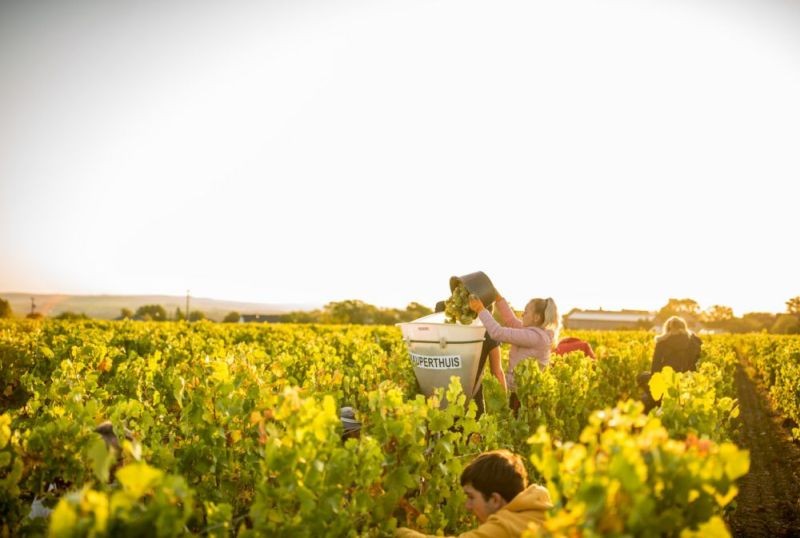
23 Jul What is “Orange Wine”
By: Robert Handjes What is the difference between red, orange and white wine? The most common answer to that question is: “the color”. But that is actually incorrect. Red wine is not a white wine with a color but a completely different product. Read further on what makes Orange wine so distinctive. White wines are made exclusively from the juice of grapes. After arriving in the cellar, the grapes (possibly after being crushed first) are immediately pressed and the juice is collected. Because the color of blue grapes is only in the skin, not in the pulp, the juice is also colorless. That juice is then fermented into (white) wine.
Aromas
With red wine, things are very different. Red wine is the result of an extraction process. Upon arrival in the cellar, the blue grapes are crushed and then the must – in this case the whole of pulp and skins – is fermented. During this fermentation, all kinds of substances, including the dye, are extracted from the skins; the dye does not dissolve well in water, but it does so much better in an alcohol, which is created during fermentation. That is also the reason why a red wine stain can be removed much better with white wine than with water. The longer the fermenting must and then the very young wine remains in contact with the skins, the more colour, but also tannin and a number of aromas are extracted from the skins. Only when the winemaker decides that the extraction is optimal, does the entire wine and skins go to the press. In short: with white wine, juice comes out of the press, with red wine, it is wine that comes out of the press. That makes white wines more difficult to make, because grape juice is a lot more sensitive to oxidation than wine; and red wines are also more resistant to oxidation than white wines due to their tannin.
“Macération pelliculaire”
This was how it went for a long time, until some innovative winemakers in the 1970s started experimenting with skin contact in white wines. They realized that the skin of some green grapes, such as Sauvignon Blanc, also contained interesting aroma components. These winemakers developed a technique in which lightly crushed grapes were stored at a very low temperature for up to several days prior to pressing: so cool that no fermentation took place and no tannin was extracted, but in which aromas from the skin did end up in the juice. This technique of cold skin maceration, in French “macération pellicular”, has since become very popular and has produced many modern, aromatic wines, often from grapes that previously only produced very neutral-tasting wines that were hardly worth the effort. Since the turn of the century, some winemakers have been experimenting with a technique that actually goes back to classical antiquity. At that time, most wines, both red and white, were fermented together with the skins. This reduced the risk of oxidation, but it did mean that white wine in the time of the Romans and Greek antiquity was much closer than that of today. And this also applies to the wines that are now made on a small scale in this very classical way: it has created a new category, which is internationally known as “orange wine”, because of the somewhat orangey colour of this type of wine. Often these “orange wines”, in a quest for authenticity, are also fermented in earthenware jars, a modern version of the Roman amphora. The very mild form of oxidation that takes place in such an amphora removes the somewhat rough tannin edges of the wine and thus benefits the wine greatly. The most successful examples of “orange wine” are particularly interesting, but should certainly not be judged as a “white wine with a deeper hue”; they are completely different wines, with their own palette of aromas and their own taste recommendation. A beautiful and very successful example is the Chablis Cuvée Amphore from Domaine de Mauperthuis. The hand-harvested grapes, originating from the heart of the Chablis appellation, are destemmed, lightly crushed and then fermented (with wild yeast) in an amphora of red Tuscan clay. The skins remain in contact with the young wine for 12 months, after which the pulp is pressed in a vertical hand press. The orange wine is then bottled without clarification or filtration. The wine is deep golden yellow with a pink sparkle. In the aroma apricot jam and mango, hint of iodine, pepper, roses and acacia. Round attack, aromas of orange, tannin structure and a long, mineral finish. Slightly chilled this is a special experience for the adventurous wine lover, a wine that combines wonderfully with a curry, with North African dishes, Korean, Japanese (soy) and with various types of (also red) meat. 



No Comments